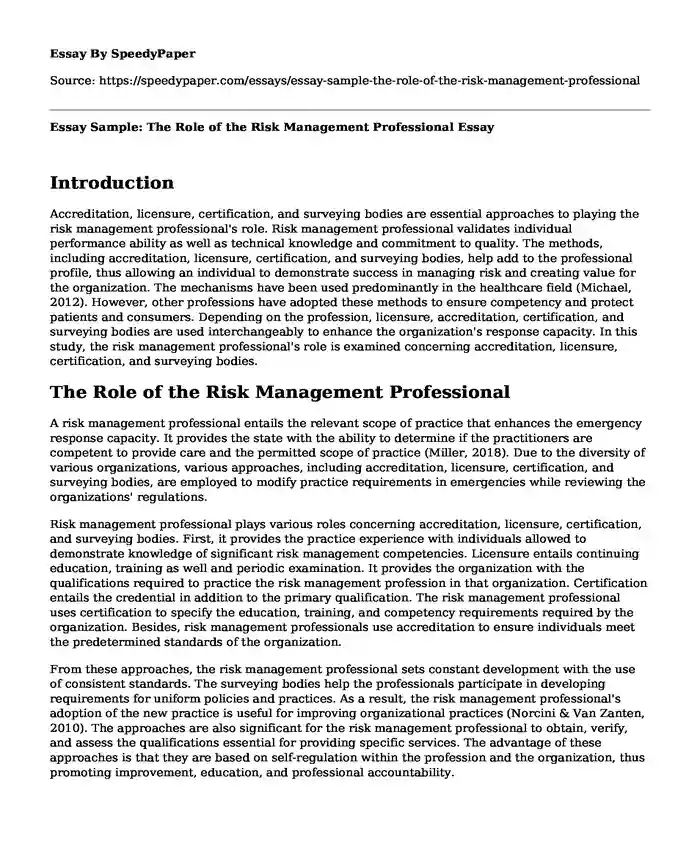
| Type of paper: | Essay |
| Categories: | Education Risk management Organizational culture |
| Pages: | 3 |
| Wordcount: | 581 words |
Introduction
Accreditation, licensure, certification, and surveying bodies are essential approaches to playing the risk management professional's role. Risk management professional validates individual performance ability as well as technical knowledge and commitment to quality. The methods, including accreditation, licensure, certification, and surveying bodies, help add to the professional profile, thus allowing an individual to demonstrate success in managing risk and creating value for the organization. The mechanisms have been used predominantly in the healthcare field (Michael, 2012). However, other professions have adopted these methods to ensure competency and protect patients and consumers. Depending on the profession, licensure, accreditation, certification, and surveying bodies are used interchangeably to enhance the organization's response capacity. In this study, the risk management professional's role is examined concerning accreditation, licensure, certification, and surveying bodies.
The Role of the Risk Management Professional
A risk management professional entails the relevant scope of practice that enhances the emergency response capacity. It provides the state with the ability to determine if the practitioners are competent to provide care and the permitted scope of practice (Miller, 2018). Due to the diversity of various organizations, various approaches, including accreditation, licensure, certification, and surveying bodies, are employed to modify practice requirements in emergencies while reviewing the organizations' regulations.
Risk management professional plays various roles concerning accreditation, licensure, certification, and surveying bodies. First, it provides the practice experience with individuals allowed to demonstrate knowledge of significant risk management competencies. Licensure entails continuing education, training as well and periodic examination. It provides the organization with the qualifications required to practice the risk management profession in that organization. Certification entails the credential in addition to the primary qualification. The risk management professional uses certification to specify the education, training, and competency requirements required by the organization. Besides, risk management professionals use accreditation to ensure individuals meet the predetermined standards of the organization.
From these approaches, the risk management professional sets constant development with the use of consistent standards. The surveying bodies help the professionals participate in developing requirements for uniform policies and practices. As a result, the risk management professional's adoption of the new practice is useful for improving organizational practices (Norcini & Van Zanten, 2010). The approaches are also significant for the risk management professional to obtain, verify, and assess the qualifications essential for providing specific services. The advantage of these approaches is that they are based on self-regulation within the profession and the organization, thus promoting improvement, education, and professional accountability.
Conclusion
Risk management professional entails quality evaluation mechanisms thus require significant planning, stakeholder support, and resource allocation, and legal support. The standard-based evaluation approaches involve a broad health sector acceptance of accreditation, licensure, certification, and surveying bodies. The approaches serve different purposes to provide various perspectives on the level of quality achieved. They also entail a set of achievable levels that stimulate improvement based on standards consistent for ensuring the organization has essential components required for providing quality care to the patients with minimum risk to health and safety. The various approaches signify that the institute recognizes the competence of the role of risk management professionals in carrying out organizational activities under the requirements defined in the international standards.
References
Michael, P. (2012). Chapter four. Professionalism, accreditation, and certification. Beyond Degrees, 3(1), 127-138. https://doi.org/10.1515/9783598440021.1.65
Miller, S. H. (2018). Globalization of the professions and the quality imperative: Trade agreements and professional accreditation, certification, and licensure. Plastic and Reconstructive Surgery, 102(7), 2505-2506. https://doi.org/10.1097/00006534-199812000-00043
Norcini, J., & Van Zanten, M. (2010). An overview of accreditation, certification, and licensure processes. International Encyclopedia of Education, 3(2), 1-6. https://doi.org/10.1016/b978-0-08-044894-7.01041-1
Cite this page
Essay Sample: The Role of the Risk Management Professional. (2023, Dec 14). Retrieved from https://speedypaper.com/essays/essay-sample-the-role-of-the-risk-management-professional
Request Removal
If you are the original author of this essay and no longer wish to have it published on the SpeedyPaper website, please click below to request its removal:
- Essay Sample: Conflict Resolution Outline
- Free Essay on McDonald's: Policy and Strategy in Global Competition Case Study
- Essay Sample: Language as a Mask in Bruce Norris' Clybourne Park
- Free Essay Sample: Design and Plan Learning Activities
- Free Essay Example: Design and Build a Route
- What Are the Benefits of a WHS Management Information System? Essay Example
- Free Essay Example: Lead at a Professional Conference
Popular categories




